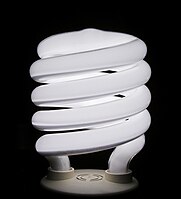
Photo from wikipedia
Abstract In this work, a low-temperature plasma initiated in liquid media between electrodes has been shown to be able to decompose hydrogen containing organic molecules resulting in obtaining gaseous products… Click to show full abstract
Abstract In this work, a low-temperature plasma initiated in liquid media between electrodes has been shown to be able to decompose hydrogen containing organic molecules resulting in obtaining gaseous products with volume part of hydrogen higher than 90% as well as nanoparticles of discharge electrodes material. As feedstocks, organic compounds (alcohols, esters) as well as direct water-hydrocarbon emulsions obtained by ultrasonic treatment are used. It is shown that hydrogen productivity from emulsions is not less than that from individual substances. The method of optical spectroscopy was used to confirm the formation of atomic hydrogen in the reactions of plasma decomposition of liquids and to study of plasma characteristics in this process. The measurement of the amount of the gas mixture and nanosized products formed during the decomposition of organic liquids shows that the output is highly dependent on the discharge current, and also on the volume of the discharge, which can vary depending on the distance between the electrodes in the reaction chamber. The dependence of the glow intensity of the discharge on its parameters and materials of the discharge electrodes is shown. In current experiments, the discharge current is from 4A to 8A, the discharge voltage depending on the type of liquid is 30–45 V. It has been found that the simultaneous excitation of an electric arc discharge and acoustic cavitation in water, organic liquids and their mixtures is an effective method for the synthesis of gaseous hydrogen and various types of solid nanoparticles. Ultrasonic action above the cavitation threshold intensifies heat and mass transfer processes in the treated medium, promotes the homogenization of dispersed systems, activation of the surface of solid particles, the appearance of defects in crystal structures due to dislocations and the formation of vacancy complexes, in combination with an electric discharge, which contributes to the appearance of an ionized state of matter (plasma); such an effect is capable of decomposing complex molecules to an atomic state with subsequent recombination and the formation of simple molecules. It has been shown that this is an energetically favorable method for the conversion of liquid-phase compounds, stimulated by thermally nonequilibrium plasma, which produces active particles – excited molecules and radicals, which makes it possible to initiate chain reactions, including energetically branched ones, and thereby significantly accelerate the process of liquid conversion and decrease the temperature allowing for such conversion. Synthesized metal and metal oxide nanoparticles from electrode materials possess activated surface due to the ultrasonic cavitation and can be subsequently used as functional nanoparticles, e.g. nanoparticles with antibacterial properties as well as components of polymer composite materials.
Journal Title: International Journal of Hydrogen Energy
Year Published: 2020
Link to full text (if available)
Share on Social Media: Sign Up to like & get
recommendations!